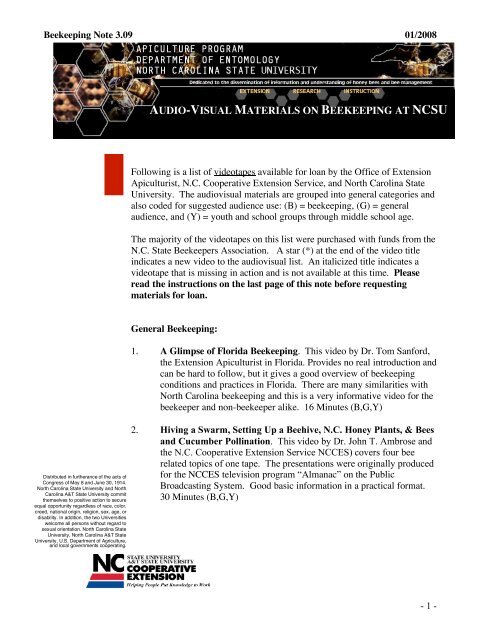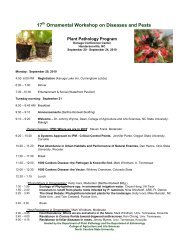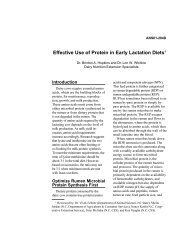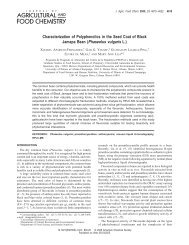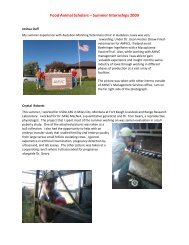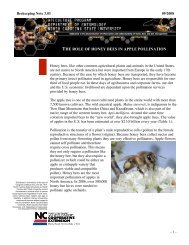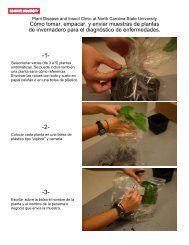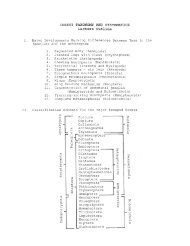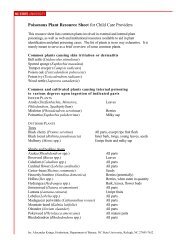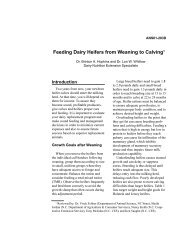audio-visual materials on beekeeping at ncsu - College of ...
audio-visual materials on beekeeping at ncsu - College of ...
audio-visual materials on beekeeping at ncsu - College of ...
Create successful ePaper yourself
Turn your PDF publications into a flip-book with our unique Google optimized e-Paper software.
Beekeeping Note 3.09 01/2008<br />
Distributed in furtherance <strong>of</strong> the acts <strong>of</strong><br />
C<strong>on</strong>gress <strong>of</strong> May 8 and June 30, 1914.<br />
North Carolina St<strong>at</strong>e University and North<br />
Carolina A&T St<strong>at</strong>e University commit<br />
themselves to positive acti<strong>on</strong> to secure<br />
equal opportunity regardless <strong>of</strong> race, color,<br />
creed, n<strong>at</strong>i<strong>on</strong>al origin, religi<strong>on</strong>, sex, age, or<br />
disability. In additi<strong>on</strong>, the two Universities<br />
welcome all pers<strong>on</strong>s without regard to<br />
sexual orient<strong>at</strong>i<strong>on</strong>. North Carolina St<strong>at</strong>e<br />
University, North Carolina A&T St<strong>at</strong>e<br />
University, U.S. Department <strong>of</strong> Agriculture,<br />
and local governments cooper<strong>at</strong>ing.<br />
AUDIO-VISUAL MATERIALS ON BEEKEEPING AT NCSU<br />
Following is a list <strong>of</strong> videotapes available for loan by the Office <strong>of</strong> Extensi<strong>on</strong><br />
Apiculturist, N.C. Cooper<strong>at</strong>ive Extensi<strong>on</strong> Service, and North Carolina St<strong>at</strong>e<br />
University. The <str<strong>on</strong>g>audio</str<strong>on</strong>g><str<strong>on</strong>g>visual</str<strong>on</strong>g> <str<strong>on</strong>g>m<strong>at</strong>erials</str<strong>on</strong>g> are grouped into general c<strong>at</strong>egories and<br />
also coded for suggested audience use: (B) = <strong>beekeeping</strong>, (G) = general<br />
audience, and (Y) = youth and school groups through middle school age.<br />
The majority <strong>of</strong> the videotapes <strong>on</strong> this list were purchased with funds from the<br />
N.C. St<strong>at</strong>e Beekeepers Associ<strong>at</strong>i<strong>on</strong>. A star (*) <strong>at</strong> the end <strong>of</strong> the video title<br />
indic<strong>at</strong>es a new video to the <str<strong>on</strong>g>audio</str<strong>on</strong>g><str<strong>on</strong>g>visual</str<strong>on</strong>g> list. An italicized title indic<strong>at</strong>es a<br />
videotape th<strong>at</strong> is missing in acti<strong>on</strong> and is not available <strong>at</strong> this time. Please<br />
read the instructi<strong>on</strong>s <strong>on</strong> the last page <strong>of</strong> this note before requesting<br />
<str<strong>on</strong>g>m<strong>at</strong>erials</str<strong>on</strong>g> for loan.<br />
General Beekeeping:<br />
1. A Glimpse <strong>of</strong> Florida Beekeeping. This video by Dr. Tom Sanford,<br />
the Extensi<strong>on</strong> Apiculturist in Florida. Provides no real introducti<strong>on</strong> and<br />
can be hard to follow, but it gives a good overview <strong>of</strong> <strong>beekeeping</strong><br />
c<strong>on</strong>diti<strong>on</strong>s and practices in Florida. There are many similarities with<br />
North Carolina <strong>beekeeping</strong> and this is a very inform<strong>at</strong>ive video for the<br />
beekeeper and n<strong>on</strong>-beekeeper alike. 16 Minutes (B,G,Y)<br />
2. Hiving a Swarm, Setting Up a Beehive, N.C. H<strong>on</strong>ey Plants, & Bees<br />
and Cucumber Pollin<strong>at</strong>i<strong>on</strong>. This video by Dr. John T. Ambrose and<br />
the N.C. Cooper<strong>at</strong>ive Extensi<strong>on</strong> Service NCCES) covers four bee<br />
rel<strong>at</strong>ed topics <strong>of</strong> <strong>on</strong>e tape. The present<strong>at</strong>i<strong>on</strong>s were originally produced<br />
for the NCCES televisi<strong>on</strong> program “Almanac” <strong>on</strong> the Public<br />
Broadcasting System. Good basic inform<strong>at</strong>i<strong>on</strong> in a practical form<strong>at</strong>.<br />
30 Minutes (B,G,Y)<br />
- 1 -
Beekeeping Note 3.09 01/2008<br />
3. Winter Feeding <strong>of</strong> the Bee Col<strong>on</strong>y, Robbing H<strong>on</strong>ey from a Beehive, and Extracting<br />
H<strong>on</strong>ey. This video by Dr. John T. Ambrose and the N.C. Cooper<strong>at</strong>ive Extensi<strong>on</strong> Service<br />
(NCCES) covers three rel<strong>at</strong>ed <strong>beekeeping</strong> topics <strong>on</strong> <strong>on</strong>e thirty minute tape. The<br />
present<strong>at</strong>i<strong>on</strong>s were originally produced for the NCCES televisi<strong>on</strong> program “Almanac” <strong>on</strong><br />
the Public Broad Casting System. Good practical inform<strong>at</strong>i<strong>on</strong>. 30 Minutes (B)<br />
Also available <strong>on</strong> DVD.<br />
4. Bees for Hire. An older but still very useful coverage <strong>of</strong> the h<strong>on</strong>ey bee col<strong>on</strong>y and the<br />
life cycles <strong>of</strong> the bees and the bee col<strong>on</strong>y. Some excellent photographic coverage <strong>of</strong> the<br />
structure <strong>of</strong> the bee col<strong>on</strong>y and its inhabitants. Nectar collecti<strong>on</strong>, pollin<strong>at</strong>i<strong>on</strong>, bee<br />
development, swarming, queen development and much more. The film was produced by<br />
Texaco Inc and does c<strong>on</strong>tain some advertising, but it is still a very inform<strong>at</strong>ive video for<br />
new beekeepers, experienced beekeepers, and any<strong>on</strong>e interested in h<strong>on</strong>ey bees.<br />
24 Minutes (B,G,Y)<br />
5. Early Spring Management.* This video was produced by Dr. Larry C<strong>on</strong>nor. It<br />
includes, Program 1: A Look <strong>at</strong> Over-Wintered Col<strong>on</strong>ies, and Program 2: Col<strong>on</strong>ies with<br />
Problems. (1985) 56 Minutes (B)<br />
6. Spring Management I. This video was produced by Dr. Larry C<strong>on</strong>nor. It includes,<br />
Program 3: Making Increases in a Beeyard, and Program 4: Queen Management. A good<br />
coverage <strong>of</strong> spring management in the beeyard including inspecting the col<strong>on</strong>ies, dividing<br />
col<strong>on</strong>ies, and equalizing the food stores and bee numbers am<strong>on</strong>g the col<strong>on</strong>ies. Dr.<br />
C<strong>on</strong>nor also discusses/dem<strong>on</strong>str<strong>at</strong>es requeening, identifying queenless col<strong>on</strong>ies, and<br />
developing a queen bank. (1985) 56 Minutes (B)<br />
7. Spring Management II.* This video was produced by Dr. Larry C<strong>on</strong>nor. It includes,<br />
Program 5: Making Col<strong>on</strong>ies with a Double Screen, and Program 6: H<strong>on</strong>ey Bee Swarms.<br />
(1985) 56 Minutes (B)<br />
8A. Shook Swarm Comb H<strong>on</strong>ey Producti<strong>on</strong>. This video fe<strong>at</strong>ures Dr. Larry C<strong>on</strong>nor and Dr.<br />
Richard Taylor and describes the “shook-swarm” system th<strong>at</strong> Dr. Taylor uses to produce<br />
comb (round secti<strong>on</strong>) h<strong>on</strong>ey. The coverage is under New York c<strong>on</strong>diti<strong>on</strong>s but it is <strong>of</strong><br />
some interest to N.C. beekeepers who want to make comb h<strong>on</strong>ey secti<strong>on</strong>s. 28 Minutes<br />
(B)<br />
8B. The H<strong>on</strong>ey House. This video by Dr. Larry C<strong>on</strong>nor and Dr. Richard Taylor is a visit to<br />
Jerry Ely’s h<strong>on</strong>ey house in Pennsylvania. Mr. Ely’s h<strong>on</strong>ey house is set up for both h<strong>on</strong>ey<br />
extracting and h<strong>on</strong>ey bottling and the tape should be <strong>of</strong> interest to most beekeepers. 28<br />
Minutes (B)<br />
9. A Year with the Bees. This video was produced by Jim Paysen <strong>of</strong> JZ’s Bees and he<br />
describes <strong>on</strong>e <strong>of</strong> his “typical” years. He covers everything from queen rearing to pollen<br />
drying. The video is not very polished but it is interesting. 2 Hours (B)<br />
- 2 -
Beekeeping Note 3.09 01/2008<br />
10. Queen Rearing. This video by Dr. James Tew, the Extensi<strong>on</strong> Apiculturist in Ohio, and<br />
the A.I. Root Company does a good job <strong>of</strong> covering several different methods <strong>of</strong> queen<br />
rearing. Good coverage for the serious beekeeper. 75 Minutes (B)<br />
11. Artificial Insemin<strong>at</strong>i<strong>on</strong> <strong>of</strong> the Queen H<strong>on</strong>ey Bee. This video by Dr. James Tew, the<br />
Extensi<strong>on</strong> Apiculturist in Ohio, provides good coverage <strong>of</strong> the use <strong>of</strong> the equipment used<br />
to artificially insemin<strong>at</strong>e queen h<strong>on</strong>ey bees. Of limited interest to most but <strong>of</strong> more<br />
interest to a few. 25 Minutes (B)<br />
12. Requeening and Col<strong>on</strong>y Divisi<strong>on</strong>. This tape was produced by Dauenhauer Producti<strong>on</strong>s<br />
and Brushy Mountain Bee Farm in North Carolina. It covers the practices <strong>of</strong> six different<br />
commercial beekeepers used in requeening and dividing col<strong>on</strong>ies. Good coverage <strong>of</strong> the<br />
actual hands-<strong>on</strong> practices. 60 Minutes (B)<br />
13. Beekeeping-Equipment and Site Selecti<strong>on</strong>. A Canadian video which provides good<br />
coverage <strong>on</strong> apiary site selecti<strong>on</strong> and equipment selecti<strong>on</strong> under Canadian c<strong>on</strong>diti<strong>on</strong>s.<br />
There are some differences between Canada and North Carolina but this is still a useful<br />
video. 35 Minutes (B)<br />
14. A Look <strong>at</strong> Queen and Package Bee Producti<strong>on</strong>. This video is by Dauenhouer<br />
Producti<strong>on</strong>s and Brushy Mountain Bee Farm in North Carolina. Steve Forrest visits<br />
several queen breeders and package bee producers and discusses queen rearing, artificial<br />
insemin<strong>at</strong>i<strong>on</strong> <strong>of</strong> queen h<strong>on</strong>ey bees and package bee producti<strong>on</strong>. 60 Minutes (B)<br />
15. Free Bees. This video is by Dauenhauer Producti<strong>on</strong>s and Brushy Mountain Bee Farm in<br />
North Carolina. It dem<strong>on</strong>str<strong>at</strong>es the removal <strong>of</strong> h<strong>on</strong>ey bee col<strong>on</strong>ies from trees and from<br />
Houses. 45 Minutes (B)<br />
16. How to Get Started - Taking H<strong>on</strong>ey Bees From a Building. This video by Dr. James<br />
Tew, the Extensi<strong>on</strong> Apiculturist in Ohio, and the U.S. Dept. <strong>of</strong> Agriculture’s Extensi<strong>on</strong><br />
Service dem<strong>on</strong>str<strong>at</strong>es how a beekeeper can remove h<strong>on</strong>ey bees from a building. This can<br />
be a seemingly inexpensive way to get a col<strong>on</strong>y <strong>of</strong> bees but it does require c<strong>on</strong>siderable<br />
amounts <strong>of</strong> time, labor and some equipment. 18 Minutes (B)<br />
17. An Introducti<strong>on</strong> to Beekeeping. This video by Ed Weiss takes you through the typical<br />
four seas<strong>on</strong>s <strong>of</strong> <strong>beekeeping</strong>. Almost everything from installing a package to packaging<br />
the h<strong>on</strong>ey is covered. 58 Minutes (B,G,Y)<br />
18. A Year in the Life <strong>of</strong> an Apiary. This is an eight episode video series <strong>on</strong> two tapes by<br />
Keith Delaplane, the Extensi<strong>on</strong> Apiculturist in Georgia. The tapes provide excellent<br />
coverage <strong>of</strong> the basics <strong>of</strong> <strong>beekeeping</strong> and should be <strong>of</strong> value to the beginning or the more<br />
experienced beekeeper. This tape series could be used as part <strong>of</strong> a local short course or<br />
bee school. 120 Minutes (B)<br />
19. Swarm Boxes - A Revoluti<strong>on</strong>ary Management Tool. Brought to you by Brushy<br />
Mountain Bee Farm, Steve Forrest visits Paul Brown (am<strong>on</strong>g others) who dem<strong>on</strong>str<strong>at</strong>es<br />
- 3 -
Beekeeping Note 3.09 01/2008<br />
how to use swarm traps and pherom<strong>on</strong>e lures. Good for folks who want to c<strong>at</strong>ch (free)<br />
swarms in the spring. 50 Minutes (B)<br />
20. Setting Up a Package Swarm. Colvin Alchis<strong>on</strong> provides a nice review <strong>of</strong> how to<br />
establish a new h<strong>on</strong>ey bee col<strong>on</strong>y from a package. Ideal for a new beekeeper who is<br />
starting from scr<strong>at</strong>ch. 41 Minutes (B)<br />
21. Keeping Bees and Producing H<strong>on</strong>ey: An Introducti<strong>on</strong>. Steve Forrest talks with Dr.<br />
John Ambrose <strong>at</strong> NCSU about educ<strong>at</strong>i<strong>on</strong>al resources for <strong>beekeeping</strong>, dem<strong>on</strong>str<strong>at</strong>es hive<br />
c<strong>on</strong>structi<strong>on</strong> with his wife Sandy, shows how to put <strong>on</strong> protective clothing, dem<strong>on</strong>str<strong>at</strong>es<br />
how to keep col<strong>on</strong>ies in an urban setting, reviews some basic h<strong>on</strong>ey bee biology, and<br />
reviews a gre<strong>at</strong> number <strong>of</strong> management practices and techniques including h<strong>on</strong>ey<br />
extracti<strong>on</strong> and bottling. Truly a wealth <strong>of</strong> inform<strong>at</strong>i<strong>on</strong>. 2 Hours, 33 Minutes (B,G)<br />
Bee Diseases, Pests, and Africanized H<strong>on</strong>ey Bees:<br />
22. Varroa jacobs<strong>on</strong>i - Biology, Research & C<strong>on</strong>trol. This video by the Bayer Corp.<br />
(maker <strong>of</strong> the coumaphos impregn<strong>at</strong>ed bee strips) is somewh<strong>at</strong> d<strong>at</strong>ed but it has some<br />
excellent photography <strong>of</strong> the varroa mite in the beehive and <strong>on</strong> h<strong>on</strong>ey bees.<br />
32 Minutes (B)<br />
23. Varroa Mite Detecti<strong>on</strong>. This video by Dr. Tom Sanford, the Extensi<strong>on</strong> Apiculturist in<br />
Florida, provides some good coverage <strong>of</strong> the varroa mite, even though it is a little d<strong>at</strong>ed.<br />
He describes the introducti<strong>on</strong> <strong>of</strong> the mite into the U.S. and some <strong>of</strong> the detecti<strong>on</strong><br />
methods. 12 Minutes (B)<br />
24. Bee Diseases. This tape was produced by Dauenhauer Producti<strong>on</strong>s and Brushy Mountain<br />
Bee Farm in North Carolina. It provides discussi<strong>on</strong>s <strong>of</strong> the major h<strong>on</strong>ey bee diseases by<br />
several apicultural researchers. Most <strong>of</strong> the tape is discussi<strong>on</strong> with little video coverage<br />
<strong>of</strong> the diseases or diseased bees but it is <strong>of</strong> some interest. 30 Minutes (B)<br />
25. Varroa Mite. This video is by Dauenhauer Producti<strong>on</strong>s and Brushy Mountain Bee Farm<br />
in North Carolina. It provides coverage <strong>of</strong> varroa mites including some biology,<br />
detecti<strong>on</strong>, and c<strong>on</strong>trol. Several researchers and commercial beekeepers are involved. 60<br />
Minutes (B)<br />
26. Tracheal Mite Detecti<strong>on</strong> & Preventi<strong>on</strong>. This video is by Dauenhauer Producti<strong>on</strong>s and<br />
Brushy Mountain Bee Farm in North Carolina. Steve Forrest discusses tracheal mites<br />
and their c<strong>on</strong>trol with several researchers. 60 Minutes (B)<br />
27. Africanized Bees-Learning to Live With Them. This video by Dr. James Tew, the<br />
Extensi<strong>on</strong> Apiculturist in Ohio, and the U.S. Dept. <strong>of</strong> Agriculture’s Extensi<strong>on</strong> Service<br />
shows how beekeepers and the general public are dealing with Africanized h<strong>on</strong>ey bees in<br />
Texas and in Mexico. The video presents a realistic overview <strong>of</strong> a situ<strong>at</strong>i<strong>on</strong> th<strong>at</strong> has been<br />
overdram<strong>at</strong>ized by the media and misunderstood by the public. An excellent video <strong>on</strong> a<br />
topic <strong>of</strong> importance to all beekeepers regardless <strong>of</strong> where they live. 21 Minutes (B,G,Y)<br />
- 4 -
Beekeeping Note 3.09 01/2008<br />
28. Africanized H<strong>on</strong>ey Bees - Destroying Africanized Bee Hives. This video by Dr.<br />
James Tew, the Extensi<strong>on</strong> Apiculturist in Ohio, and the U.S. Dept <strong>of</strong> Agriculture’s<br />
Extensi<strong>on</strong> Service dem<strong>on</strong>str<strong>at</strong>es how the beekeeper, the homeowner, or any<strong>on</strong>e can<br />
“safely” destroy a col<strong>on</strong>y <strong>of</strong> Africanized h<strong>on</strong>ey bees. The practical use <strong>of</strong> this video is<br />
primarily for those st<strong>at</strong>es th<strong>at</strong> have been invaded by Africanized h<strong>on</strong>ey bees, but the<br />
procedures can be used effectively to elimin<strong>at</strong>e any aggressive (overly defensive) col<strong>on</strong>y<br />
<strong>of</strong> h<strong>on</strong>ey bees. 15 Minutes (B)<br />
Note: This video also c<strong>on</strong>tains Africanized Bees-Learning to Live With Them.<br />
29. C<strong>on</strong>trolling Varroa Mites and Small Hive Beetles in H<strong>on</strong>ey Bee Col<strong>on</strong>ies. This short<br />
video dem<strong>on</strong>str<strong>at</strong>es how to use CheckMite, the brand name <strong>of</strong> coumaphos, for its ability<br />
to comb<strong>at</strong> two <strong>of</strong> the more notable parasites <strong>of</strong> managed bee col<strong>on</strong>ies in North Carolina.<br />
12 Minutes (B)<br />
30. DVD - Working with Mite-Away II.* A complete how-to for <strong>on</strong>e <strong>of</strong> the newest<br />
tre<strong>at</strong>ments for varroa and tracheal mites, Mite-Away II pads with formic acid. Highly<br />
recommended for any<strong>on</strong>e wishing to use this new product. (2005) 10 Minutes (B)<br />
Pollin<strong>at</strong>i<strong>on</strong>:<br />
31. Pollin<strong>at</strong>i<strong>on</strong>. This video by the N<strong>at</strong>i<strong>on</strong>al Geographic Society provides excellent general<br />
coverage <strong>of</strong> pollin<strong>at</strong>i<strong>on</strong> in general. There is some but limited coverage <strong>of</strong> actual h<strong>on</strong>ey<br />
bee pollin<strong>at</strong>i<strong>on</strong> <strong>of</strong> plants. This is an excellent video for the beekeeper, the general<br />
public, and youth/school groups th<strong>at</strong> are interested in learning about pollin<strong>at</strong>i<strong>on</strong>. 23<br />
Minutes (B,G,Y)<br />
32. Sexual Encounters <strong>of</strong> the Floral Kind. This fascin<strong>at</strong>ing video by the Center for the<br />
Humanities examines the wide range <strong>of</strong> methods th<strong>at</strong> have developed in various plants to<br />
<strong>at</strong>tract insect pollin<strong>at</strong>ors. The emphasis is not <strong>on</strong> h<strong>on</strong>ey bees and h<strong>on</strong>ey bee pollin<strong>at</strong>i<strong>on</strong>,<br />
but r<strong>at</strong>her <strong>on</strong> a glimpse <strong>of</strong> some <strong>of</strong> the more “unusual” developments by some flowering<br />
plants to <strong>at</strong>tract insect pollin<strong>at</strong>ors. See how flowers mimic insects, decaying animal<br />
m<strong>at</strong>ter and much more in their efforts to insure pollin<strong>at</strong>i<strong>on</strong>. There is even some<br />
fascin<strong>at</strong>ing video coverage <strong>of</strong> bird and mammal pollin<strong>at</strong>i<strong>on</strong> <strong>of</strong> plants. 48 Minutes (B,G)<br />
33. Pollin<strong>at</strong>i<strong>on</strong>: The Insect C<strong>on</strong>necti<strong>on</strong>. This video by the Carolina Biological Supply<br />
Company presents the co-evoluti<strong>on</strong> <strong>of</strong> plants and their pollin<strong>at</strong>ors and these remarkable<br />
plant-insect rel<strong>at</strong>i<strong>on</strong>ships. This video gives a brief overview <strong>of</strong> the role th<strong>at</strong> insects play<br />
in the ecosystem by pollin<strong>at</strong>ing flowering plants. 14 Minutes (G,Y)<br />
34. Beekeeping: A Unique Industry. Pollin<strong>at</strong>i<strong>on</strong> and Bees: A Good Arrangement.*<br />
This video produced by Ohio St<strong>at</strong>e University discusses many different aspects <strong>of</strong> h<strong>on</strong>ey<br />
bee pollin<strong>at</strong>i<strong>on</strong>. Topics include flower morphology and how pollin<strong>at</strong>i<strong>on</strong> works, the<br />
rel<strong>at</strong>i<strong>on</strong>ship between the h<strong>on</strong>ey bee and the plant, and the effect pollin<strong>at</strong>i<strong>on</strong> has <strong>on</strong> crop<br />
yield. 1Hour, 41 Minutes (B,G,Y)<br />
Also available <strong>on</strong> DVD.<br />
- 5 -
Beekeeping Note 3.09 01/2008<br />
35. Pollin<strong>at</strong>i<strong>on</strong>: The future, science and business.* Produced by Bee Culture. This video is<br />
series <strong>of</strong> speakers <strong>of</strong> various backgrounds involved in the pollin<strong>at</strong>i<strong>on</strong> business. This<br />
video is based <strong>on</strong> experiences in California, but would also be relevant for North<br />
Carolina. Topics include alm<strong>on</strong>d pollin<strong>at</strong>i<strong>on</strong>, genetically modified crops, dealing<br />
Africanized h<strong>on</strong>ey bees, writing pollin<strong>at</strong>i<strong>on</strong> c<strong>on</strong>tracts, and other legal issues beekeepers<br />
might face. Recommended for beekeepers in the pollin<strong>at</strong>i<strong>on</strong> business. *TIME* (B)<br />
Also available <strong>on</strong> DVD.<br />
H<strong>on</strong>ey and Hive Products:<br />
36. From Bee to Bottle. This video by Art Halstead, a N.C. Master Beekeeper w<strong>on</strong> the<br />
NCSBA’s Am<strong>at</strong>eur Video Award <strong>at</strong> <strong>on</strong>e <strong>of</strong> the Associ<strong>at</strong>i<strong>on</strong>’s Summer C<strong>on</strong>venti<strong>on</strong>s. It<br />
provides good coverage for the hobby beekeeper and the processes <strong>of</strong> robbing (removing)<br />
h<strong>on</strong>ey from the hive, extracting the h<strong>on</strong>ey, and bottling the final product.<br />
15 Minutes (B,G,Y)<br />
37. The H<strong>on</strong>ey C<strong>on</strong>sumer in the 90's. This video by Mary Humann and the N<strong>at</strong>i<strong>on</strong>al<br />
H<strong>on</strong>ey Board presents some important and interesting inform<strong>at</strong>i<strong>on</strong> about who is<br />
c<strong>on</strong>suming h<strong>on</strong>ey. The inform<strong>at</strong>i<strong>on</strong> is based <strong>on</strong> real studies, which describe who is<br />
buying h<strong>on</strong>ey (particularly in the store) and how the h<strong>on</strong>ey is being used. The tape also<br />
deals with a number <strong>of</strong> ideas and myths regarding h<strong>on</strong>ey. The tape does stop short <strong>of</strong><br />
telling you how to reach new c<strong>on</strong>sumers, but it does have some very good inform<strong>at</strong>i<strong>on</strong> <strong>on</strong><br />
potential customers. 35 Minutes (B)<br />
38. Is Commercial Beekeeping Really Pr<strong>of</strong>itable? This video by Dr. Tom Sanford, the<br />
Extensi<strong>on</strong> Apiculturist in Florida) and the N<strong>at</strong>i<strong>on</strong>al H<strong>on</strong>ey Board examines the costs and<br />
pr<strong>of</strong>itability <strong>of</strong> commercial <strong>beekeeping</strong>. Following Dr. Sanford’s present<strong>at</strong>i<strong>on</strong>, three<br />
commercial beekeepers discuss their <strong>beekeeping</strong> oper<strong>at</strong>i<strong>on</strong>s. An excellent video for any<br />
hobby or sideline beekeeper who is c<strong>on</strong>sidering increasing their bee oper<strong>at</strong>i<strong>on</strong>.<br />
45 Minutes (B)<br />
39. Is Exporting (H<strong>on</strong>ey) in Your Future? This video by the N<strong>at</strong>i<strong>on</strong>al H<strong>on</strong>ey Board is<br />
coverage <strong>of</strong> a seminar by Wayne Molstad who is a Promoti<strong>on</strong>s Specialist with the U.S.<br />
Dept <strong>of</strong> Agriculture. Mr. Molstad describes some <strong>of</strong> the USDA resources th<strong>at</strong> are<br />
available to those individuals who are “serious” about selling their products overseas.<br />
The quality <strong>of</strong> the speaker present<strong>at</strong>i<strong>on</strong> is good but he does reference overheads<br />
(overhead transparencies) which are not visible <strong>on</strong> the tape. 30 Minutes (B)<br />
40. Caviar Promoti<strong>on</strong>s <strong>on</strong> a Baked Bean Budget. This videotape from the N<strong>at</strong>i<strong>on</strong>al H<strong>on</strong>ey<br />
presents a seminar by Mary Lye who is a H<strong>on</strong>ey Promoti<strong>on</strong> Specialist employed by the<br />
Canadian government. She describes a number <strong>of</strong> methods to improve h<strong>on</strong>ey promoti<strong>on</strong><br />
th<strong>at</strong> involve little or no cost to the promoter/beekeeper. Her ideas seem to be very useful<br />
and straight forward. The quality <strong>of</strong> her present<strong>at</strong>i<strong>on</strong> is very good but she does reference<br />
overhead transparencies in her talk which are not visible <strong>on</strong> the tape. However, just<br />
listening to her present<strong>at</strong>i<strong>on</strong> could spark a few useful ideas for the viewer. 30 Minutes (B)<br />
- 6 -
Beekeeping Note 3.09 01/2008<br />
41. H<strong>on</strong>ey in the Comb. This video by Eugene Killi<strong>on</strong>, an expert <strong>on</strong> making comb h<strong>on</strong>ey,<br />
provides excellent coverage <strong>on</strong> all aspects <strong>of</strong> making round and square secti<strong>on</strong>s <strong>of</strong> comb<br />
h<strong>on</strong>ey. This is a gre<strong>at</strong> video for all beekeepers, even those who have no intenti<strong>on</strong> <strong>of</strong> ever<br />
making comb h<strong>on</strong>ey. 35 Minutes (B)<br />
42. The Art <strong>of</strong> the Sting: Bee Venom Therapy. This video is the first in “The Art <strong>of</strong> the<br />
Sting” series by James R. Higgins (1998) <strong>of</strong> Hillsboro, OH. Higgins reviews the benefits<br />
<strong>of</strong> h<strong>on</strong>ey bee acupuncture, part <strong>of</strong> an apitherapy program. He lectures and dem<strong>on</strong>str<strong>at</strong>es<br />
how to administer stings to maximize the benefits. 35 Minutes (G)<br />
43. The Art <strong>of</strong> the Sting: Nerve Centers for Arthritis and Multiple Sclerosis. This video<br />
is the sec<strong>on</strong>d in “The Art <strong>of</strong> the Sting” series by James R. Higgins (1998). This video<br />
shows how to find the correct points <strong>of</strong> the body to get stung for therapeutic purposes. 38<br />
Minutes (G)<br />
44. The Art <strong>of</strong> the Sting: The Care and Maintenance <strong>of</strong> Bees for Therapy. This video is<br />
the third in “The Art <strong>of</strong> the Sting” series by James R. Higgins (1998). Some basic<br />
pointers <strong>on</strong> how to effectively obtain bees from a hive for apitherapy. 29 Minutes (B,G)<br />
45. The Magic <strong>of</strong> Mead.* This video is by Dauenhauer Producti<strong>on</strong>s and Brushy Mountain<br />
Bee Farm in North Carolina. Tricks and secrets <strong>of</strong> making Mead. 60 Minutes (G)<br />
46. Candle Making for Every<strong>on</strong>e.* This video is by Dauenhauer Producti<strong>on</strong>s and Brushy<br />
Mountain Bee Farm in North Carolina. A must-see video for any<strong>on</strong>e interested in<br />
making beeswax candles. Dem<strong>on</strong>str<strong>at</strong>es several techniques and styles. (1991) 1Hour, 12<br />
Minutes (G,Y)<br />
H<strong>on</strong>ey Bees in General and Rel<strong>at</strong>ed Insects:<br />
47. Life Cycle <strong>of</strong> the H<strong>on</strong>ey Bee. This program examines the h<strong>on</strong>ey bee col<strong>on</strong>y in detail<br />
and follows the complete life cycle: laying and h<strong>at</strong>ching <strong>of</strong> eggs, feeding <strong>of</strong> larvae,<br />
sealing the cells, making the coco<strong>on</strong>s, and development <strong>of</strong> the pupae. The sec<strong>on</strong>d part<br />
deals with behavior <strong>of</strong> dr<strong>on</strong>es and foraging. (1991) 21 Minutes (G,Y)<br />
48. Bee Beards, Bee Stings, & C<strong>on</strong>trolling Wasps. This video by Dr. John T. Ambrose and<br />
the N.C. Cooper<strong>at</strong>ive Extensi<strong>on</strong> Service (NCCES) covers three vaguely bee rel<strong>at</strong>ed topics<br />
<strong>on</strong> <strong>on</strong>e thirty minute tape. The present<strong>at</strong>i<strong>on</strong>s were originally produced for the NCCES<br />
televisi<strong>on</strong> program “Almanac” <strong>on</strong> the Public Broadcasting System. Inform<strong>at</strong>i<strong>on</strong> <strong>of</strong><br />
general use to beekeepers and n<strong>on</strong>-beekeepers alike. 30 Minutes (B,G,Y)<br />
49. Biography <strong>of</strong> a Bee. This video by the Moody Institute <strong>of</strong> Science provides good<br />
coverage <strong>of</strong> the bee col<strong>on</strong>y and its inhabitants. Excellent photography and good coverage<br />
<strong>of</strong> the bees performing routine tasks such as nectar collecti<strong>on</strong>, h<strong>on</strong>ey processing etc. 14<br />
Minutes (B,G,Y)<br />
- 7 -
Beekeeping Note 3.09 01/2008<br />
50. M<strong>at</strong>hem<strong>at</strong>ics <strong>of</strong> the H<strong>on</strong>ey Comb. H<strong>on</strong>ey bees as m<strong>at</strong>hem<strong>at</strong>icians. This video shows<br />
how we have figured out wh<strong>at</strong> the h<strong>on</strong>ey bees knew all al<strong>on</strong>g. The six sided, hexag<strong>on</strong>,<br />
bee cell is much str<strong>on</strong>ger than a round or square cell. The program is fairly technical but<br />
interesting. 13 Minutes (B,G,Y)<br />
51. The M<strong>on</strong>k and the H<strong>on</strong>ey Bee. Excellent coverage <strong>of</strong> the life <strong>of</strong> Brother Adam and his<br />
development <strong>of</strong> the Buckfast Bee. Brother Adam, a Benedictine m<strong>on</strong>k, devoted much <strong>of</strong><br />
his life to developing the Buckfast Bee to deal with the devast<strong>at</strong>i<strong>on</strong> th<strong>at</strong> was initially<br />
caused by tracheal mites (Isle <strong>of</strong> Wight Disease) in the U.K. One <strong>of</strong> the heroes <strong>of</strong><br />
<strong>beekeeping</strong>. 90 Minutes (B,G,Y)<br />
52. Life <strong>of</strong> the H<strong>on</strong>ey Bee. This videotape by the Films for Humanities and the Sciences<br />
provides detailed coverage <strong>of</strong> organiz<strong>at</strong>i<strong>on</strong> and activities <strong>of</strong> the h<strong>on</strong>ey bee col<strong>on</strong>y. The<br />
photographic coverage <strong>of</strong> the bees and their activities is excellent and helps to increase<br />
both the beekeeper and the n<strong>on</strong>-beekeeper’s understanding <strong>of</strong> these fascin<strong>at</strong>ing insects. 44<br />
Minutes (B,G,Y)<br />
53. The Evoluti<strong>on</strong> <strong>of</strong> Social Behavior in Bees. This videotape by the Films for the<br />
Humanities and the Sciences tells the story <strong>of</strong> how cooper<strong>at</strong>ive social behavior developed<br />
in the bees and the wasps including h<strong>on</strong>ey bees, bumble bees, and the social wasps.<br />
H<strong>on</strong>ey bees are not unique in being social insects and this video does a good job <strong>of</strong><br />
showing how sociality has developed in several different insect groups.<br />
54 Minutes (B,G,Y)<br />
54. Insect Diversity. This good general introducti<strong>on</strong> to the diversity <strong>of</strong> insects describes the<br />
characteristics th<strong>at</strong> define an insect and shows examples <strong>of</strong> the many different insect<br />
types. Each example is shown using eye-c<strong>at</strong>ching close-up photography, with gre<strong>at</strong> use<br />
<strong>of</strong> time-elapsed sequences. Topics include types <strong>of</strong> metamorphosis, wings and<br />
mouthparts. Also covered are molting, types <strong>of</strong> color<strong>at</strong>i<strong>on</strong> and camouflage, pred<strong>at</strong>ory<br />
insects, herbivorous insects, parasites, insect/plant rel<strong>at</strong>i<strong>on</strong>ships, pollin<strong>at</strong>i<strong>on</strong> and social<br />
insects with a good tre<strong>at</strong>ment <strong>of</strong> h<strong>on</strong>ey bees. 25 Minutes (B,G,Y)<br />
55. Bees: Backyard Science.* A decent overview <strong>of</strong> basic bee biology and a nice<br />
introducti<strong>on</strong> to h<strong>on</strong>ey extracti<strong>on</strong>. (1978) 15 Minutes (B,G,Y)<br />
56. The Birth <strong>of</strong> the Bees.* Learn about h<strong>on</strong>ey bees by learning about their close rel<strong>at</strong>ives!<br />
This video tells the story <strong>of</strong> the evoluti<strong>on</strong> <strong>of</strong> cooper<strong>at</strong>ive social behavior in digger wasps,<br />
mas<strong>on</strong> bees, bumblebees, h<strong>on</strong>ey bees, and others. It also explores the genetic theory <strong>of</strong><br />
kin selecti<strong>on</strong> th<strong>at</strong> underlies the evoluti<strong>on</strong> <strong>of</strong> sociality in social insects. (1995) 55 Minutes<br />
(G,Y)<br />
57. Tales from the Hive.* This NOVA video exposes a bee col<strong>on</strong>y’s secret world –<br />
detailing such rarely seen events as the life-or-de<strong>at</strong>h b<strong>at</strong>tle between a pair <strong>of</strong> rival queens,<br />
a bee e<strong>at</strong>er’s <strong>at</strong>tack <strong>on</strong> the hive, and a scout bee’s mysterious dance th<strong>at</strong> shares special<br />
“nectar directi<strong>on</strong>s” with the rest <strong>of</strong> the hive. Also, w<strong>at</strong>ch the high-speed mid-air<br />
- 8 -
Beekeeping Note 3.09 01/2008<br />
“wedding flight” <strong>of</strong> a dr<strong>on</strong>e and queen. (1998) 60 Minutes (G,Y)<br />
Bees and the Public:<br />
58. Visit to a H<strong>on</strong>ey Bee Farm. This video by Journal Films Inc. depicts a tour <strong>of</strong> an apiary<br />
by a beekeeper and two children. In additi<strong>on</strong> to observing bees working in the and about<br />
the hive, there is also coverage <strong>of</strong> h<strong>on</strong>ey collecting and processing. This video is <strong>of</strong><br />
good general interest particularly to youth/school groups. 10 Minutes (B,Y)<br />
59. Wh<strong>at</strong>’s Buzzing? This video was produced by the N<strong>at</strong>i<strong>on</strong>al H<strong>on</strong>ey Board depicts a TV<br />
News form<strong>at</strong> with several children discussing the importance <strong>of</strong> h<strong>on</strong>ey bees and<br />
pollin<strong>at</strong>i<strong>on</strong>. An excellent program for school age children. 10 Minutes (B,Y)<br />
60. C<strong>on</strong>trolling H<strong>on</strong>ey Bee Emergencies.* Cre<strong>at</strong>ed by A. I. Root Company for Fire<br />
Departments, this video is a must-see for first resp<strong>on</strong>ders – including beekeepers – for<br />
bee spills or other accidents involving h<strong>on</strong>ey bees. It shows how to effectively handle the<br />
four most comm<strong>on</strong> h<strong>on</strong>ey bee emergencies, the equipment you need, and how to use it.<br />
(1992) 30 Minutes (B,G)<br />
INSTRUCTIONS FOR REQUESTING VIDEOTAPES<br />
1. All requests should be made by email or writing 2 weeks in advance <strong>of</strong> planned use to<br />
allow for shipping. We do not hold videos, so please do not request a video prior to 2<br />
weeks before the planned use d<strong>at</strong>e. Make sure to list altern<strong>at</strong>e choices in case your first<br />
choice is not available.<br />
All requests should be made through your local County Extensi<strong>on</strong> Office or your local<br />
Beekeeping Chapter. Address requests to: Jean Carter, Admin. Support Assoc.<br />
Master Beekeeper Program<br />
Department <strong>of</strong> Entomology<br />
Campus Box 7613<br />
North Carolina St<strong>at</strong>e University<br />
Raleigh, NC 27695-7613<br />
-or-<br />
Email: jean_carter@<strong>ncsu</strong>.edu<br />
2. Due to the popularity and demand for these <str<strong>on</strong>g>visual</str<strong>on</strong>g> <str<strong>on</strong>g>m<strong>at</strong>erials</str<strong>on</strong>g>, we are able to loan <strong>on</strong>ly<br />
ONE video <strong>at</strong> a time. Please do not ask for more than <strong>on</strong>e video.<br />
3. Videos may be checked out for no more than 30 days before being c<strong>on</strong>sidered overdue.<br />
4. Please return tapes promptly to the address above after viewing.<br />
- 9 -


